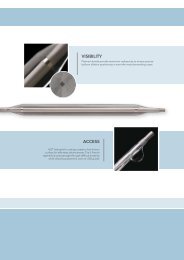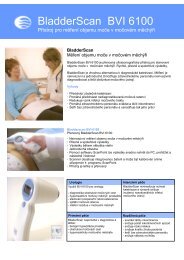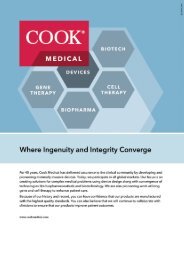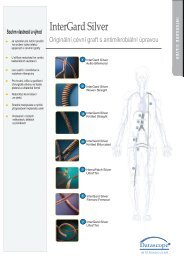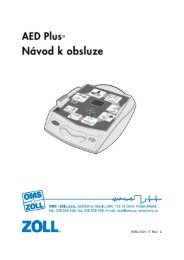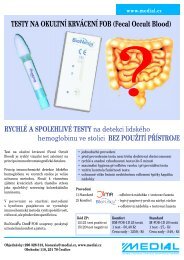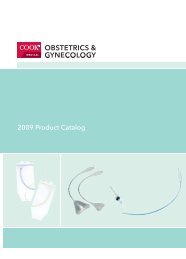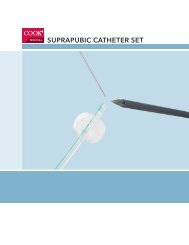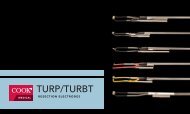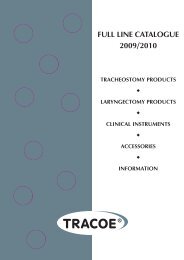The BAP test and the global assessment of oxidative stress ... - Medial
The BAP test and the global assessment of oxidative stress ... - Medial
The BAP test and the global assessment of oxidative stress ... - Medial
Create successful ePaper yourself
Turn your PDF publications into a flip-book with our unique Google optimized e-Paper software.
9. Experimental studies in vitroA recent challenge for antioxidantsupplements is <strong>the</strong> determination <strong>of</strong>antioxidant power in vitro. Indeed in <strong>the</strong> lightto develop new formulas, <strong>the</strong> producer whenpossible should report on <strong>the</strong> label at least anindication on <strong>the</strong> ability <strong>of</strong> <strong>the</strong> formula toneutralize effectively one or more oxidants.Among <strong>the</strong> available assays <strong>BAP</strong> <strong>test</strong>proven useful in <strong>the</strong> <strong>assessment</strong> <strong>of</strong> antioxidantcapacity <strong>of</strong> some formulas destined to patientsor healthy peoples (Table 7).Table 7. <strong>BAP</strong> <strong>test</strong> values <strong>of</strong> some antioxidant formulasFormulas <strong>BAP</strong> <strong>test</strong> values N CV (%)GIN PENT TM (1) 48500±2880 9 4.1DEUTROSULFAZYME TM (2) 64747± 3660 8 5.7DEUTROSULFAZYME TM (3) 235500± 9161 8 3.9DEUTROSULFAZYME TM (4) 274500± 6009 8 2.2ARAMEN TM (5) 22440 ± 908 7 4.0<strong>BAP</strong> <strong>test</strong> values are expressed as mean µEq/L±SD. N is<strong>the</strong> number <strong>of</strong> determinations. CV is <strong>the</strong> within-runcoefficient <strong>of</strong> variation. (1) Gimnostemma pentaphyllumplus fermented papaya plus reduced glutathione (2)Deutrosulfazyme TM basic formula. (3) Deutrosulfazyme TMvitamin C-enriched formula. (4) Deutrosulfazyme TMmultivitamins-enriched formula. (5) Herbal product basedon Laminaria digitata, Condrus crispus, Sambucus nigra,Vaccinium myrtillus, Rosa canina <strong>and</strong> Feniculus vulgareMiller.Among <strong>the</strong>se was also Deutrosulfazyme TM(CELLFOOD TM , NUSCIENCE CORPORATION,US) a non-addictive, non-invasive, <strong>and</strong>completely non-toxic proprietary colloidal-ionicformula containing finest all-natural, plantbasedorganic substances like ionic minerals,enzymes, amino acids <strong>and</strong> deuterium sulphateas traces (51, 52).More recently <strong>BAP</strong> <strong>test</strong> was performedcomparatively on samples <strong>of</strong> h<strong>and</strong>-made beersagainst to industrial beers(Table 8) (Bianchi<strong>and</strong> Iorio, unpublished data).Table 8. <strong>BAP</strong> <strong>test</strong> values <strong>and</strong> polyphenols levels inh<strong>and</strong>-made <strong>and</strong> industrial beers.Beer <strong>BAP</strong> <strong>test</strong> values* Polyphenols levels**Label 1 10035 583Label 2 9750 517Label 3 9655 631Label 4 9645 904Label 5 10375 700Label 6 7280 477Label 7 9515 451Label 8 11040 938Label 9 9860 629Label 10*** 6080 316*As µEq/L. **As mg catechin/kg. ***IndustrialInterestingly h<strong>and</strong> made beers showedhigher values <strong>of</strong> both <strong>BAP</strong> <strong>test</strong> <strong>and</strong> polyphenolscompared to industrial beers. Noticeably <strong>BAP</strong><strong>test</strong> values correlated with polyphenolscontent.10. Indications <strong>and</strong> clinical usefulness<strong>The</strong> <strong>BAP</strong> <strong>test</strong>, by exploiting <strong>the</strong> samechemical principle <strong>of</strong> <strong>the</strong> well-known FRAP <strong>test</strong>– i. e. <strong>the</strong> reduction <strong>of</strong> ferric to ferrous ions –provides a reliable measure <strong>of</strong> biologicalantioxidant potential <strong>of</strong> blood plasma (53).<strong>The</strong>refore, <strong>the</strong> <strong>BAP</strong> <strong>test</strong> should beperformed with <strong>the</strong> aim <strong>of</strong> assessing <strong>the</strong>antioxidant status ei<strong>the</strong>r in healthy peoples, inorder to prevent <strong>oxidative</strong> <strong>stress</strong>, or in patientswith <strong>oxidative</strong> <strong>stress</strong>-related diseases, in orderto monitor <strong>the</strong> efficacy <strong>of</strong> specific <strong>and</strong>/orantioxidant <strong>the</strong>rapies (54, 55).All healthy peoples should undergo <strong>the</strong> <strong>BAP</strong><strong>test</strong> because all <strong>the</strong> individuals are potentiallyexposed to <strong>the</strong> risk <strong>of</strong> producingexaggerate amounts <strong>of</strong> free radicals, aphenomenon which requires a very effectiveantioxidant barrier. Indeed, <strong>the</strong> primary aim <strong>of</strong>this <strong>test</strong> is to identify <strong>and</strong> to prevent <strong>oxidative</strong><strong>stress</strong> <strong>and</strong> its unwanted consequences (earlyaging, diseases) (56).All <strong>the</strong> more so, <strong>the</strong> <strong>BAP</strong> <strong>test</strong> should besystematically performed on all clinicallyasymptomatic subjects, who are exposed for anumber <strong>of</strong> reasons to factors able to reducephysiological antioxidant plasma defenses (e.g. inadequate exercise, unbalanced diet,chronic inflammatory diseases with reduced17www.fras4evolvo.it



